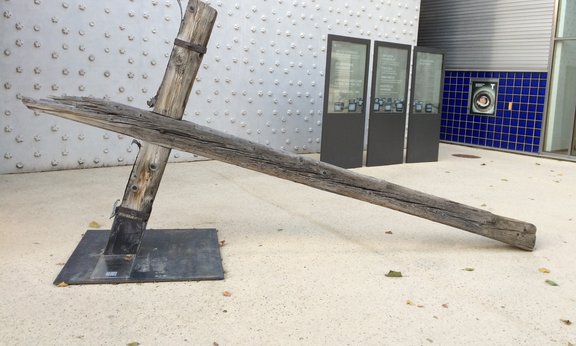The erection of the first summit cross at the Piz Buin was celebrated in the Christian-conservative newspaper Volksblatt in the issue from 15 September 1936 with the title: “The Crusade of the Reichsbund to the Piz Buin.” A detailed and in some parts dramatically worded report of the ascent followed. It stressed the heroic actions of the participating “crusaders” and narrated the particular circumstances of the erection, which weren’t known when the cross was replaced. “There was no date on the cross and it was assumed that it dated from the 1950s or 1960s,” says Michael Kasper, an academic at the Institute of History and European Ethnology and Director at the Montafon Museums (Montafoner Museen). He was commissioned by the vorarlberg museums to look into the history of this historical cross. The newspaper article in Volksblatt mentioned above, which Kasper found during his research, indicates the political element of the act, which is nowadays completely acceptable. Already the title of the article suggests the fighting spirit that was one of the defining traits of the Reichsbund Youth. As one of the most influential Catholic youth organizations in Austria it initiated and carried out the erection of the summit cross. “Considering the context of that time it was a very symbolic act that also stirred up resistance,” says Michael Kasper, referring to a section at the beginning of the article. It said that it was “a symbol that this country is and will remain Christian despite the onslaught of the conquerors of Christendom.” With the “conquerors of Christendom” they referred to the competing National Socialists and, even more so, the Bolsheviks or Communists. Against this background it comes as no surprise that the erection of the summit cross triggered different responses in the media. The German-national newspaper Tagblatt, for example, did not report it at all, some other newspapers mentioned it only in a small entry, and the magazine Österreichische Woche (Austrian Week) showed a picture of it.
Concerns of the Austrian League for Nature Conservation
Apart from entries in historical media reports, which are Michael Kasper’s main information source, he also found sporadic references to the summit cross at the Piz Buin in government archives, where he came upon an interesting detail: Although the Reichsbund had the government agencies of the Austro-fascist Ständestaat (Corporate State) on its side, the authorization was given only after the erection of the cross. The authorities had received complaints from the Austrian League for Nature Conservation, expressing concern about the cross’ intrusion into the pristine Alpine landscape. “Today nobody would even think that a summit cross doesn’t fit into the landscape,” says Kasper with a twinkle in his eyes, at the same time drawing attention to the politically explosive nature of the topic then. “After the Anschluss in 1938 official communication mentioned that the cross was considered a symbol of the Systemzeit (Time of the System) – a term the National Socialist Party used to describe the time of the Ständestaat in Austria – and should be removed,” explains Kasper. He assumes that this was never undertaken because the Piz Buin was located in the restricted zone at the Swiss border. Kasper knows about several summit crosses in the Tyrol that were destroyed or removed by the NS regime.
First summit cross in Vorarlberg
Kasper also found out that the summit cross at the Piz Buin was the first one in the province of Vorarlberg. This surprised him as the first summit crosses, commissioned by Archduke John, had already been erected in the 19th century and could increasingly be found not only in the Catholic areas of the province of the Tyrol but also in the southern parts of the Alps. “The big wave of cross erections started after the Second World War, when returning soldiers put them up on the local mountains surrounding their village,” reports Michael Kasper, who regards his research as an exemplary contribution to this little studied research field. While there are studies about individual summit crosses and some photo and inscription collections, very few general contributions about the development of this rather new phenomenon exist.
Facts about the summit cross erection
All facts that are known today about the process of erecting the summit cross at the Piz Buin are derived from the Vorarlberg newspaper Volksblatt and from a memorial publication about the mounting of the cross owned by Reichsbund functionary Eugen Leissing: The idea to erect a summit cross was born at a meeting (“Gautag”) of the Reichsbund Youth organization in Schruns on 21 May 1936. The project was then carried out in cooperation with several other Reichsbund groups. They were supported by the Illwerke (the local power generating company), which provided the incline elevator for transportation, for example. The groups’ first attempt to erect the cross on 5 September failed due to bad weather. On the following Saturday, 18 young men from the Montafon valley carried the cross to the Wiesbadner Grätle (ridge). On Sunday 13 September 1936 they finally mounted and secured it. In summer 2015, the historical cross was exhibited in an art installation in Bregenz, Austria, on the occasion of the celebration of the first ascent to the Piz Buin 150 years ago.
About Michael Kasper
Michael Kasper, born in 1980, graduated from the University of Innsbruck in History, Social Science and Political Science, Geography and Economics as well as Catholic Religion. His main research focus is on the social history of rural areas and the history of cultural landscape. He is a faculty member at the Institute of History and European Ethnology and Director of the Montafon museums (Montafoner Museen).

